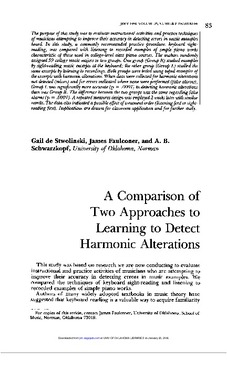| dc.contributor.author | Gail de Stwolinski | |
| dc.contributor.author | James Faulconer | |
| dc.contributor.author | A. B. Schwarzkopf | |
| dc.date.accessioned | 2016-01-14T19:53:59Z | |
| dc.date.accessioned | 2016-03-30T15:31:17Z | |
| dc.date.available | 2016-01-14T19:53:59Z | |
| dc.date.available | 2016-03-30T15:31:17Z | |
| dc.date.issued | 1988-07-01 | |
| dc.identifier.citation | de Stwolinski, G., Faulconer, J., & Schwarzkopf, A. B. (1988). A Comparison of Two Approaches to Learning to Detect Harmonic Alterations. Journal of Research in Music Education, 36(2), 83-94. doi: 10.2307/3345242 | en_US |
| dc.identifier.uri | https://hdl.handle.net/11244/25561 | |
| dc.description.abstract | The purpose of this study was to evaluate instructional activities and practice techniques of musicians attempting to improve their accuracy in detecting errors in music examples heard. In this study, a commonly recommended practice procedure, keyboard sight-reading, was compared with listening to recorded examples of simple piano works characteristic of those used in college-level class piano courses. The authors randomly assigned 59 college music majors to two groups. One group (Group R) studied examples by sight-reading music excerpts at the keyboard; the other group (Group L) studied the same excerpts by listening to recordings. Both groups were tested using taped examples of the excerpts with harmonic alterations. When data were collected for harmonic alterations not detected (misses) and for errors indicated where none were performed (false alarms), Group L was significantly more accurate (p = .0001) in detecting harmonic alterations than was Group R. The difference between the two groups was the same regarding false alarms (p = .0001). A repeated measures design was employed 2 weeks later with similar results. The data also indicated a possible effect of treatment order (listening first or sight-reading first). Implications are drawn for classroom application and for further study. | en_US |
| dc.language.iso | en_US | en_US |
| dc.publisher | Journal of Research in Music Education | |
| dc.title | A Comparison of Two Approaches to Learning to Detect Harmonic Alterations | en_US |
| dc.type | Research Article | en_US |
| dc.description.peerreview | Yes | en_US |
| dc.description.peerreviewnotes | https://us.sagepub.com/en-us/nam/manuscript-submission-guidelines | en_US |
| dc.identifier.doi | 10.2307/3345242 | en_US |
| dc.rights.requestable | false | en_US |
